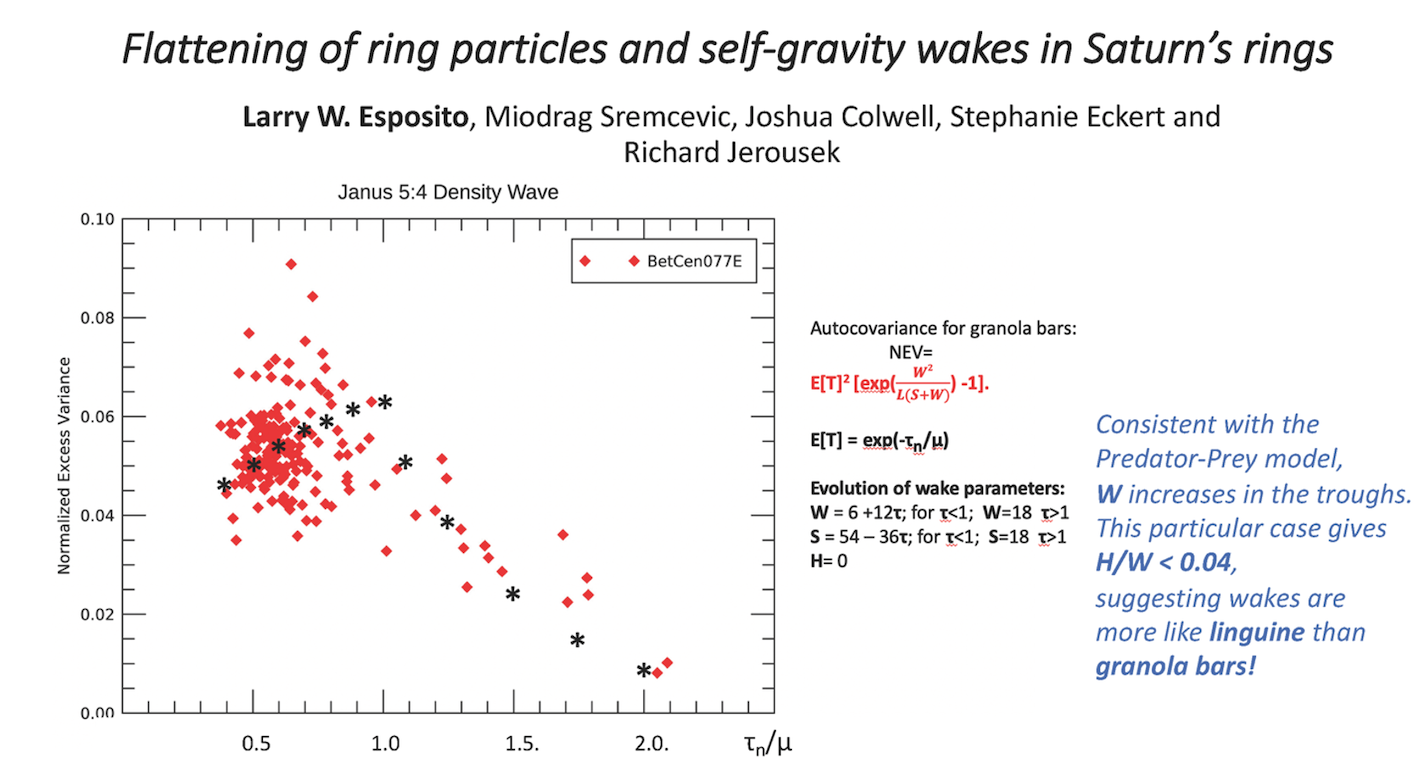- 1University of Colorado, Boulder, CO, USA
- 2UCF, Orlando, FL, USA
The varying geometry of Cassini star occultations by Saturn’s rings constrains both the size and shape of structures that block starlight. Statistics of UVIS star occultations measure structures as small as meters, on times scales of minutes to decades. We calculate the excess variance, skewness and kurtosis including the effects of irregular particle shadows, along with a granola bar model of gaps, ghosts and clumps. The widths W and separation S of rectangular clumps play an analogous role to the relative size of the particle shadows, δ. In the first model considered, our calculations are based on the moments of the transparency T in that part of the ring Asampled by the occultation, thus extending the work of Showalter and Nicholson (1990) to larger τ and δ, and to higher central moments, without their simplifying assumptions. We also calculate these statistics using an approach based on the autocovariance, autocoskewness and autocokurtosis.
These new approaches compare well to the formula for excess variance from Showalter and Nicholson in the region where all are accurate, δτ≪1. Skewness for small τ has a different sign for transparent and opaque structures, distinguishing gaps from clumps. The higher order central moments are more sensitive to the extremes of the size distribution and opacity. We explain the upward curvature of the dependence of normalized excess variance for Saturn’s background C ring by the observation of Jerousek etal (2018) that the measured optical depth is correlated with particle size. For a linear dependence Reff = 12 * (τ – 0.08) + 1.8m from Jerousek’s results, we match the curvature of normalized excess variance, the skewness and the kurtosis in the region between 78,000 and 84,600 km from Saturn.
Statistics calculated from the granola bar model give different predictions from individual particles. The different τ dependence suggests that the wave crests compress the gaps more than the wakes, and produce more regularity among the clumps; and larger and more opaque self-gravity wakes in the wave crests, with transparent ghosts. The UVIS observations fall between the most regular and the most irregular granola bar models.
We compare selected occultations (Eckert etal 2020) at different values of the elevation B to estimate the flattening and axial ratio of ring particles and clumps. In Ring C, we find spheres: The statistical measures from multiple occultations follow the expected dependence on sin B, e.g. Showalter & Nicholson (1990). However, in the Janus 2:1 and Mimas 5:3 density waves, the excess variance for stars β Cen, λ Sco and σ Sgr shows no B dependence. This is exactly the expectation for completely flat (H/W =0) self-gravity wakes that we have derived from the autocovariance of the wake shadows. A closer analysis of this particular case gives H/W < 0.04, different from Colwell etal (2007), suggesting wakes are more like linguine than granola bars.

How to cite: Esposito, L. W., Sremcevic, M., Colwell, J., Eckert, S., and Jerousek, R.: Flattening of ring particles and self-gravity wakes in Saturn’s rings, Europlanet Science Congress 2021, online, 13–24 Sep 2021, EPSC2021-854, https://doi.org/10.5194/epsc2021-854, 2021.

